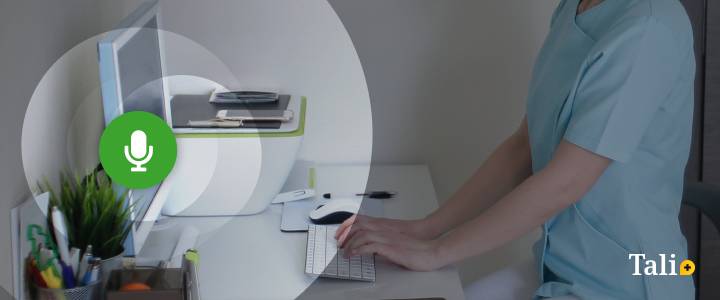Medical scribes have played a crucial role in healthcare for decades, responsible for documenting patient encounters, recording medical histories, and assisting physicians with administrative tasks. Despite their traditional importance, conventional medical scribing faces limitations such as time constraints, transcription errors, and high costs. Enter Artificial Intelligence (AI), a transformative force reshaping medical scribing, revolutionizing patient record management, and enhancing overall patient care through efficient documentation. This blog post delves into the historical evolution, roles, benefits, and challenges of traditional medical scribing, introducing AI medical scribes and exploring their seamless integration into modern healthcare systems. Finally, we conduct a comprehensive comparison between human and AI scribes, emphasizing advantages, challenges, and potential implications.
Historical Evolution of Medical Scribing
Medical scribes originated in the 1960s, initially tasked with transcribing physician notes and recording medical histories. However, with the rise of electronic health records (EHRs), their role evolved to become integral to the healthcare system, documenting patient encounters and assisting with administrative tasks.
Roles of Traditional Medical Scribing
Traditional medical scribing relies on human scribes to document patient encounters in real-time, ensuring accurate and complete physician notes. This process contributes to improved patient care, increased physician productivity, and reduced transcription errors.
Benefits of Traditional Medical Scribing
Traditional medical scribing offers benefits such as enhanced patient care, heightened physician productivity, and decreased transcription errors. Real-time documentation ensures accuracy and completeness, ultimately providing a comprehensive view of a patient's medical history.
Challenges of Traditional Medical Scribing
Despite its advantages, traditional medical scribing presents challenges, including high costs, time constraints, and potential transcription errors. These issues can be particularly burdensome for small practices.
Introduction to AI Medical Scribing
AI medical scribing leverages Artificial Intelligence to assist physicians with administrative tasks. By employing natural language processing, machine learning, and speech recognition, AI medical scribes listen to patient-provider conversations, interpret them, and draft summaries for medical records.
Technologies Involved in AI Medical Scribing
AI medical scribing integrates natural language processing, machine learning, and speech recognition to interpret conversations between healthcare providers and patients. These technologies enable accurate transcription and mimic the physician's writing style.
Seamless Integration of AI Medical Scribes into Modern Healthcare Systems
AI medical scribes seamlessly integrate into modern healthcare systems, compatible with any EHR system and customizable to meet providers' specific needs. They excel at generating SOAP notes, H&P notes, coding, and more across various specialties.
Comparison between Human and AI Scribes:
AI medical scribes surpass human counterparts in terms of reduced costs, increased accuracy, and improved efficiency. While they offer advantages, challenges include the need for customization, potential errors, and the absence of human interaction.
Current Trends in Medical Scribing
AI medical scribing is a growing trend in healthcare, transforming patient record management and assisting physicians with administrative tasks. The technology, incorporating natural language processing, machine learning, and speech recognition, is reshaping the industry.
Advantages of AI Medical Scribing
AI medical scribing presents advantages such as cost-effectiveness, accuracy, and efficiency. By utilizing advanced technologies, these scribes reduce administrative burdens and provide customizable solutions for healthcare providers.
Key Advantages of AI Medical Scribing
Enhanced Cost Efficiency: AI medical scribes dramatically cut costs compared to their human counterparts, eliminating the need for extensive training and benefits. This financial efficiency makes them an appealing solution for healthcare providers, especially those in smaller practices.
Increased Accuracy: AI medical scribes leverage advanced technologies for precise transcription, minimizing the risk of errors present in human-dependent systems.
Heightened Efficiency: Real-time note generation by AI scribes significantly reduces administrative time, allowing healthcare providers to focus more on patient care.
Adaptable Customization: Unlike traditional methods, AI medical scribes offer flexibility and customization, adapting to the specific needs of healthcare providers and diverse medical specialties.
Comparison between Traditional and AI Medical Scribing
| Feature | Traditional Medical Scribing | AI Medical Scribing |
|---|
Cost | High, with expenses related to hiring and training human scribes. | Cost-effective, with minimal training and no ongoing benefits. |
Accuracy | Human-dependent, susceptible to transcription errors. | High accuracy, leveraging advanced technologies for precise transcription. |
Efficiency | Real-time documentation can be time-consuming. | Real-time note generation, reducing administrative time significantly. |
Customization | Limited flexibility for customization. | Easily customizable to meet specific provider needs. |
Human Interaction | Direct interaction with patients. | Lacks direct human interaction, focusing on efficient documentation. |
Challenges of AI Medical Scribing
Despite its benefits, AI medical scribing faces challenges, including the need for customization, potential errors, and the absence of human interaction. Customization is crucial to meet specific provider needs, and errors may occur if conversations are misinterpreted.
Future Developments in Medical Scribing
The future of medical scribing holds exciting possibilities with continued advancements in AI medical scribing technologies. As healthcare providers seek to improve patient care and reduce costs, AI medical scribes will become more sophisticated, integrating new technologies and artificial intelligence.
Conclusion
In conclusion, the landscape of medical scribing has been revolutionized by Artificial Intelligence. AI medical scribes, with their cost-effectiveness, accuracy, and efficiency, are reshaping how healthcare providers document patient encounters and assist with administrative tasks. While challenges such as customization, potential errors, and the absence of human interaction exist, the future promises further development and integration of AI medical scribing technologies. Tali AI stands at the forefront of this evolution, providing innovative solutions that have transformed patient record management and enhanced patient care through efficient documentation. Experience the benefits of AI medical scribing firsthand by trying Tali AI for free.
